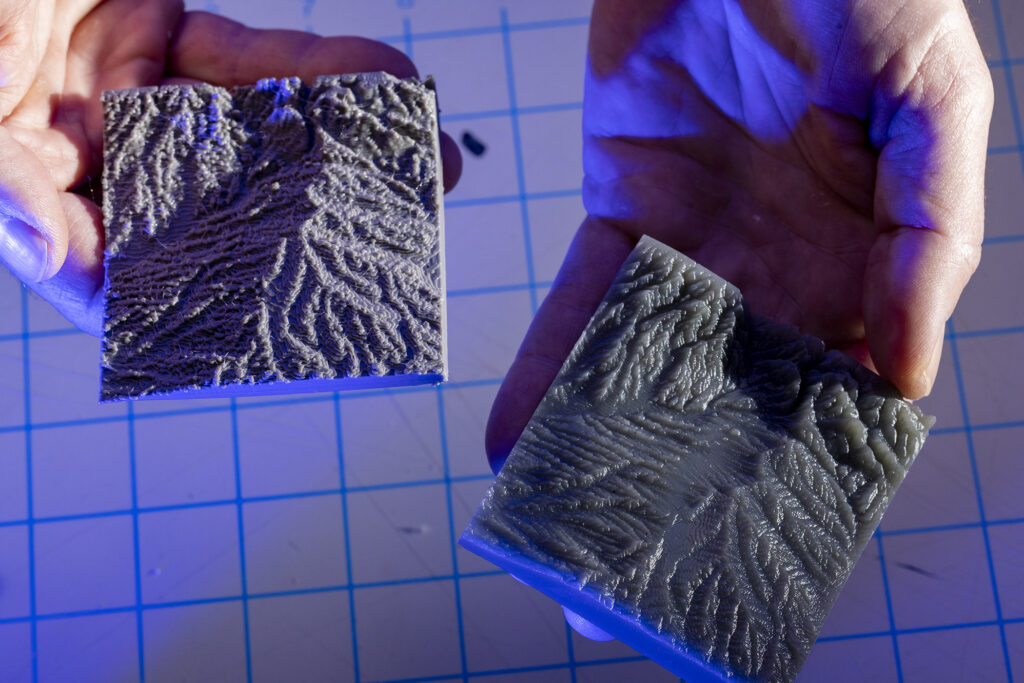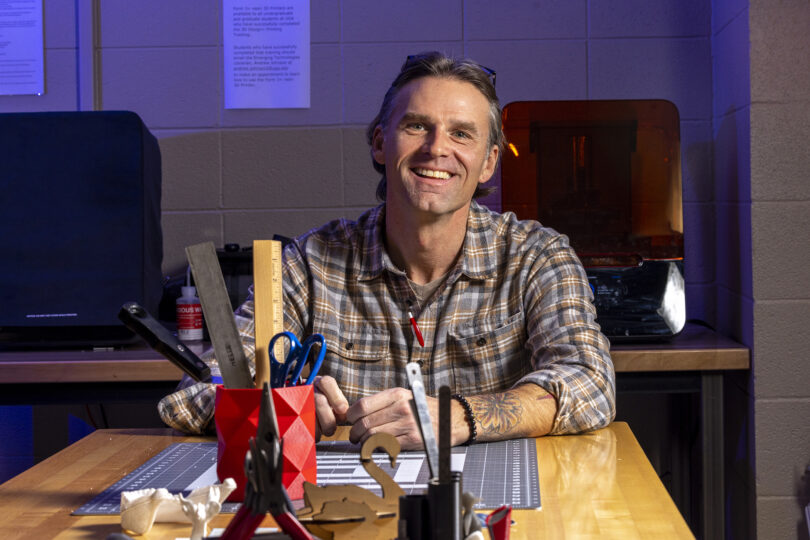Andrew Johnson isn’t just a thinker. He’s also a doer.
A first-generation college student who worked in an auto body shop while falling in love with literature, Johnson’s unconventional academic path and eclectic interests laid the foundation for his career as the emerging technologies librarian who leads the Makerspace at the University of Georgia’s McBay Science Library.
“I’ve been involved with making for as long as I can remember,” Johnson said. “My dad put tools in my hands at an early age and taught me how to use them. He instilled the values of being organized and spending effort creating high-quality items and fixing things properly.”
Not long after high school, Johnson withdrew from an auto body training program and started community college, where his professors fed his love for literature and set him on a path to the University of Connecticut and a year studying abroad in Galway, Ireland. After a few years of travel and work, Johnson’s job at a literacy non-profit drove his desire to go back to school and receive a master’s degree in library and information science from the University of Illinois at Urbana-Champaign.
It was at UIUC that Johnson found the perfect mix of thinking and doing.
“I took a networked information systems course with Professor Martin Wolske. On the first day of class, and with no prior experience, all the students learned together to dismantle non-working computers and to get them working by the end of the class period,” Johnson said. “Professor Wolske taught me the importance of observation with making and creating person-centered, sustainable technology spaces.”
At the McBay Science Library, Johnson welcomes students and faculty to create, training them in the technology that can bring their ideas to life.
“I am interested in facilitating creation,” Johnson said, adding that students are invited to take workshops to learn about the equipment but after that training, they have the flexibility to experiment with their projects. “I want individuals to be able to own their creation process and feel supported in that, be that a research paper, or making a model to be 3D printed.
“There can be complex emotions with making and approaching new technology. It’s a very individual and private process,” Johnson pointed out, adding that his background as a first-generation student reminds him how important it is to give students room for trial and error, encouraging their use of problem-solving abilities and building self-confidence. “With making and research, mistakes are part of the processes. I don’t call what comes before the final product or final paper a mistake or series of mistakes. They’re iterations with new tools and newly acquired skills. Facilitating a learning process that helps release that pressure and stress caused by internal, unrealistic expectations is important to me as an academic librarian.”

Andrew Johnson holds 3-D printed geographical elevation maps he created in the Makerspace. (Photo by Dorothy Kozlowski/UGA)
Outside of McBay, Johnson continues to tinker, restoring vintage motorcycles and hand-carving wooden spoons from wood he finds wandering in the woods with his dog. He’s also continuing his education, pursuing a master’s degree at the Warnell School of Forestry & Natural Resources.
He uses simple tools in his own making pursuits, but he always has an eye out for the technology that might drive his students’ passions. Recently, the Makerspace upgraded to Resin 3D printers, and a new embroidery and sewing machine is quickly becoming as popular as the laser-cutters and other materials.
In 2023, more than 500 students in 29 courses, including many First-Year Odyssey courses, visited the Makerspace, not to mention the more than 150 who participated in individualized training workshops and special programs such as Peach State LSAMP, UGA ESTEEMED summer programs and Destination Dawgs. But Johnson points out that most people become returning customers, learning more, trying more things, and experimenting with making.
“All my memories involve the unique makers and the very different processes each took to produce their items. One student, Asu, is a force; truly an inspiring individual. He is involved with so many interesting projects around campus and was one of the first students to learn how to use the resin 3D printers to create models for a mobile exhibit of Georgia’s oyster hatchery. A graduate student recently 3D printed devices to collect benthic specimens from the Gulf of Mexico for their research,” Johnson said. “Thinking that items from our 3D printers went to the floor of the Gulf of Mexico—that’s cool.”
Johnson went on to describe a class project to create acorn ant homes on the laser cutter and another to 3D print dog bones to practice surgery, forestry students who 3D printed eastern box turtles and gopher frogs for field research, and an engineering student who designed apparatus that could help kids to be less scared when getting their blood drawn.
“I’m lucky in that I get to know many students for the duration of their academic careers at UGA,” he said. “For me, each maker, their project, their interests and what they share with me is memorable.”








